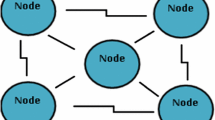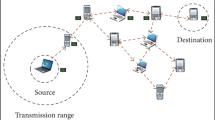Abstract
Mobile ad hoc networks (MANETs) include a collection of distinct and autonomous nodes that move independently and send data using wireless channels. Clustering and secure routing are treated as proficient techniques to achieve energy efficiency and network stability. Different methods have been presented for addressing the issues of mobility and battery limited characteristics of mobile nodes in MANETs. This paper aims to develop new cluster-based secure routing protocols in MANETs. This paper presents a new Type II fuzzy-based clustering with improved ant colony optimization-based routing (T2FCATR) protocol for secured data transmission in MANETs. Initially, a new type II fuzzy-based clustering process takes place to construct the clusters. Then, the routing issue is addressed by ACO with the Tumbling technique, which offers intercluster routing from CHs to BS. In addition, a hybrid data transmission mechanism is also involved to reduce the number of data transmissions and thereby achieve energy efficiency. The performance of the T2FCATR model has been validated against several aspects. The simulation outcome implied that the T2FCATR model achieves minimum clustering overhead, minimum variations in CHs and CMs. As a whole, it can be concluded that the T2FCATR model is superior to all the compared methods under several aspects.









Similar content being viewed by others
Explore related subjects
Discover the latest articles and news from researchers in related subjects, suggested using machine learning.References
Hyland M, Mullins BE, Baldwin RO, Temple MA (2007) Simulation-based performance evaluation of mobile ad hoc routing protocols in a swarm of unmanned aerial vehicles. In Proceedings of the 21st International Conference on Advanced Information Networking and Applications Workshops (AINAW’07), Niagara Falls, ON, Canada, 21–23 May 2007; Volume 2, pp. 249–256
Zhang H, Wang X, Memarmoshrefi P, Hogrefe D (2017) A survey of ant colony optimization based routing protocols for mobile ad hoc networks. IEEE Access 5:24139–24161
Sun W, Yang Z, Zhang X, Liu Y (2014) Energy-efficient neighbor discovery in mobile ad hoc and wireless sensor networks: a survey. IEEE Commun Surv Tutor 16:1448–1459
Polastre J, Szewczyk R, Mainwaring A, Culler D, Anderson J, (2004) Analysis of wireless sensor networks for habitat monitoring. In Wireless Sensor Networks; Springer: New York, NY, USA, pp 399–423
Tseng YC, Hsu CS, Hsieh TY (2003) Power-saving protocols for IEEE 802.11-based multi-hop ad hoc networks. Comput Netw 43:317–337
Doshi S, Bhandare S, Brown TX (2002) An on-demand minimum energy routing protocol for a wireless ad hoc network. ACM SIGMOBILE Mob Comput Commun Rev 6:50–66
Misra A, Banerjee S, (2002) MRPC: maximizing network lifetime for reliable routing in wireless environments. In Proceedings of the 2002 IEEE Wireless Communications and Networking Conference (WCNC2002), Orlando, FL, USA, 17–21 March 2002; Volume 2, pp 800–806.
Dressler F, Akan OB (2010) A survey on bio-inspired networking. Comput Netw 54:881–900
Bandgar AR, Thorat SA, (2013) An improved location-aware ant colony optimization based routing algorithm for MANETs. In Proceedings of the 2013 Fourth International Conference on Computing, Communications and Networking Technologies (ICCCNT), Tiruchengode, India, 4–6 July 2013; pp 1–6
Baras JS, Mehta HA, (2003), Probabilistic emergent routing algorithm for mobile ad hoc networks. In proceedings of the modeling and optimization in mobile, ad hoc and wireless networks (WiOpt’03), Antipolis, France, 3–5 March 2003; 10p
Osagie E, Thulasiraman P, Thulasiram RK, (2008) PACONET: improved ant colony optimization routing algorithm for mobile ad hoc networks. In Proceedings of the 22nd International Conference on Advanced Information Networking and Applications (AINA 2008), Okinawa, Japan, 25–28 March 2008; pp. 204–211
Bullnheimer B, Hartl R, Strauss CA, (1999) New rank based version of the ant system—a computational study; Vienna university of economics and business: Vienna, Austria, 1999; Volume 7, pp 25–38
Woungang I, Dhurandher SK, Obaidat MS, Ferworn A, Shah W, (2013) An ant-swarm inspired energy-efficient ad hoc on-demand routing protocol for mobile ad hoc networks. In Proceedings of the 2013 IEEE International Conference on Communications (ICC), udapest, Hungary, 9–13 June 2013; pp 3645–3649
de Figueiredo Marques V, Kniess J, Parpinelli RS, (2018) An Energy Efficient Mesh LNN Routing Protocol Based on Ant Colony optimization. In Proceedings of the 2018 IEEE 16th International Conference on Industrial Informatics (INDIN), Porto, Portugal, 18–20 July 2018; Volume 1, pp 43–48
Zhou J, Wang X, Tan H, Deng Y, (2015) Ant colony-based energy control routing protocol for mobile ad hoc networks. In Proceedings of the International Conference on Wireless Algorithms, Systems, and Applications, Qufu, China, 10–12 August 2015; Springer: New York, NY, USA, pp 845–853
Prabaharan SB, Ponnusamy R, (2016) Secure and energy efficient MANET routing incorporating trust values using hybrid ACO. In Proceedings of the 2016 International Conference on Computer Communication and Informatics (ICCCI), Coimbatore, India, 7–9 January 2016; pp 1–8
Vignesh V, Premalatha K (2019) Optimal route path sustainability in military information system with reduced interference effect. J Supercomput 75:6106–6117
Jamali S, Fotohi R (2017) DAWA: defending against wormhole attack in MANETs by using fuzzy logic and artificial immune system. J Supercomput 73:5173–5196
Zhou S, Meng X (2020) A location and time-aware resource searching scheme in mobile P2P ad hoc networks. J Supercomput 76:6809–6833 https://doi.org/10.1007/s11227-019-03139-3
Khalladi R, Rebbah M, Smail O (2021) A new efficient approach for detecting single and multiple black hole attacks. J Supercomput 77:7718–7736
Khanmohammadi E, Barekatain B, Quintana AA (2021) An enhanced AHP-TOPSIS-based clustering algorithm for high-quality live video streaming in flying ad hoc networks. J Supercomput 77:10664–10698 https://doi.org/10.1007/s11227-021-03645-3
Muthumayil K, Jayasankar T, Krishnaraj N, Sikkandar MY, Balasubramanian PN et al (2021) Maximizing throughput in wireless multimedia sensor network using soft computing techniques. Intell Autom Soft Comput 27(3):771–784
T, Vaiyapuri, Velmurugan Subbiah Parvathy, V. Manikandan, N. Krishnaraj, Deepak Gupta, and K. Shankar. "A novel hybrid optimization for cluster‐based routing protocol in information-centric wireless sensor networks for IoT based mobile edge computing." Wireless Personal Communications, pp 1–24, 2021
Author information
Authors and Affiliations
Corresponding author
Additional information
Publisher's Note
Springer Nature remains neutral with regard to jurisdictional claims in published maps and institutional affiliations.
Rights and permissions
About this article
Cite this article
Nagendranth, M.V.S.S., Khanna, M.R., Krishnaraj, N. et al. Type II fuzzy-based clustering with improved ant colony optimization-based routing (t2fcatr) protocol for secured data transmission in manet. J Supercomput 78, 9102–9120 (2022). https://doi.org/10.1007/s11227-021-04262-w
Accepted:
Published:
Issue Date:
DOI: https://doi.org/10.1007/s11227-021-04262-w




